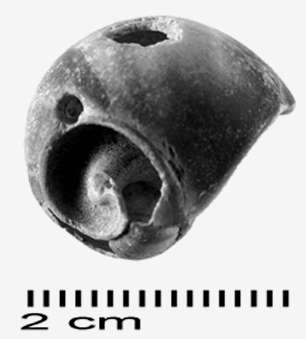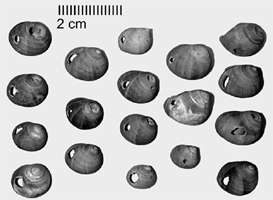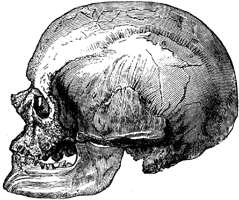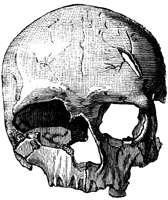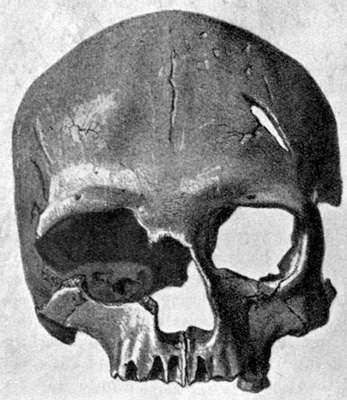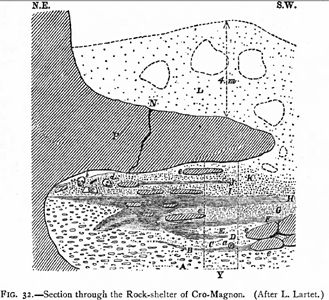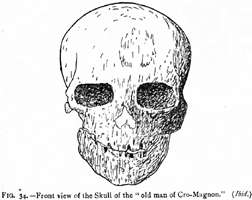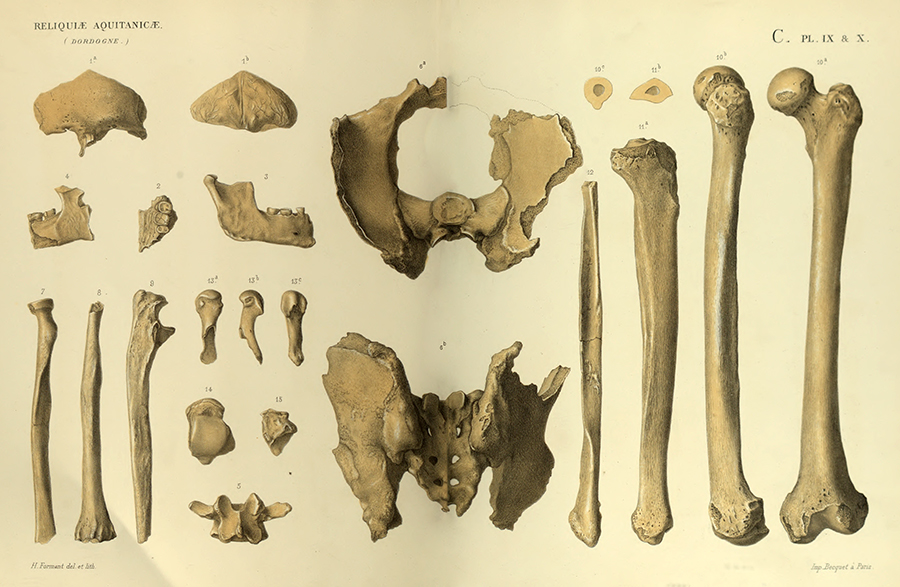The Cro-Magnon Shelter
In 1868, during road works, the remains of several individuals were identified in this shelter. They are associated with the bones of animals, knapped flint and jewellery. The best known is The Old Man of Cro-Magnon, an adult suffering from a rare bone degeneration.
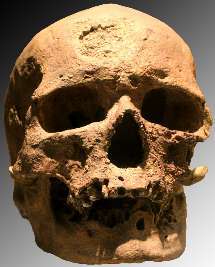
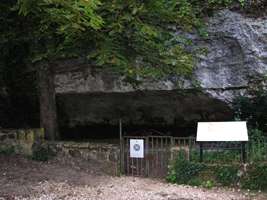
Cro-Magnon derives its name from the word "Cro" or "Creux" meaning hollow, and "Magnon" for the name of the person who originally owned the land on which the fossils were found.
The first discoveries were made by Lartet in 1868.
Photo on left and text: adapted from Wikipedia
Photo on right: Don Hitchcock 2008
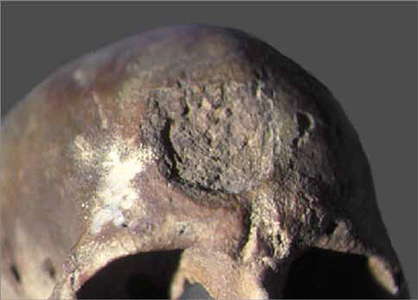
The old man of Cro-Magnon was carrying eroding bone lesions associated with Actinomyces bovis, a Gram positive bacterium.
(Actinomycosis is a Gram positive infectious bacterial disease which occurs rarely in humans but rather frequently in cattle as a disease called lumpy jaw. This name refers to the large abscesses that grow on the head and neck of the infected animal. It can also affect pigs, horses, and dogs, and less often wild animals and sheep - Wikipedia)
This non-cancerous growth occurs mainly on the flat bones, the mandible, the long bones and the ribs of the adult male, between 20 to 40 years. In this disease, undifferentiated connective tissue of the bone slowly but chronically proliferates, destroying the the bone. This condition can also give vertebral fractures, lesions that the forty year old also had, so that the diagnosis of Scheuermann's disease that may be associated with it, is, in our opinion, disputed. Patients with eosinophilic granuloma may recover, but death usually occurs by respiratory failure or cardiac arrest.
Photo and text: Delluc (2010)
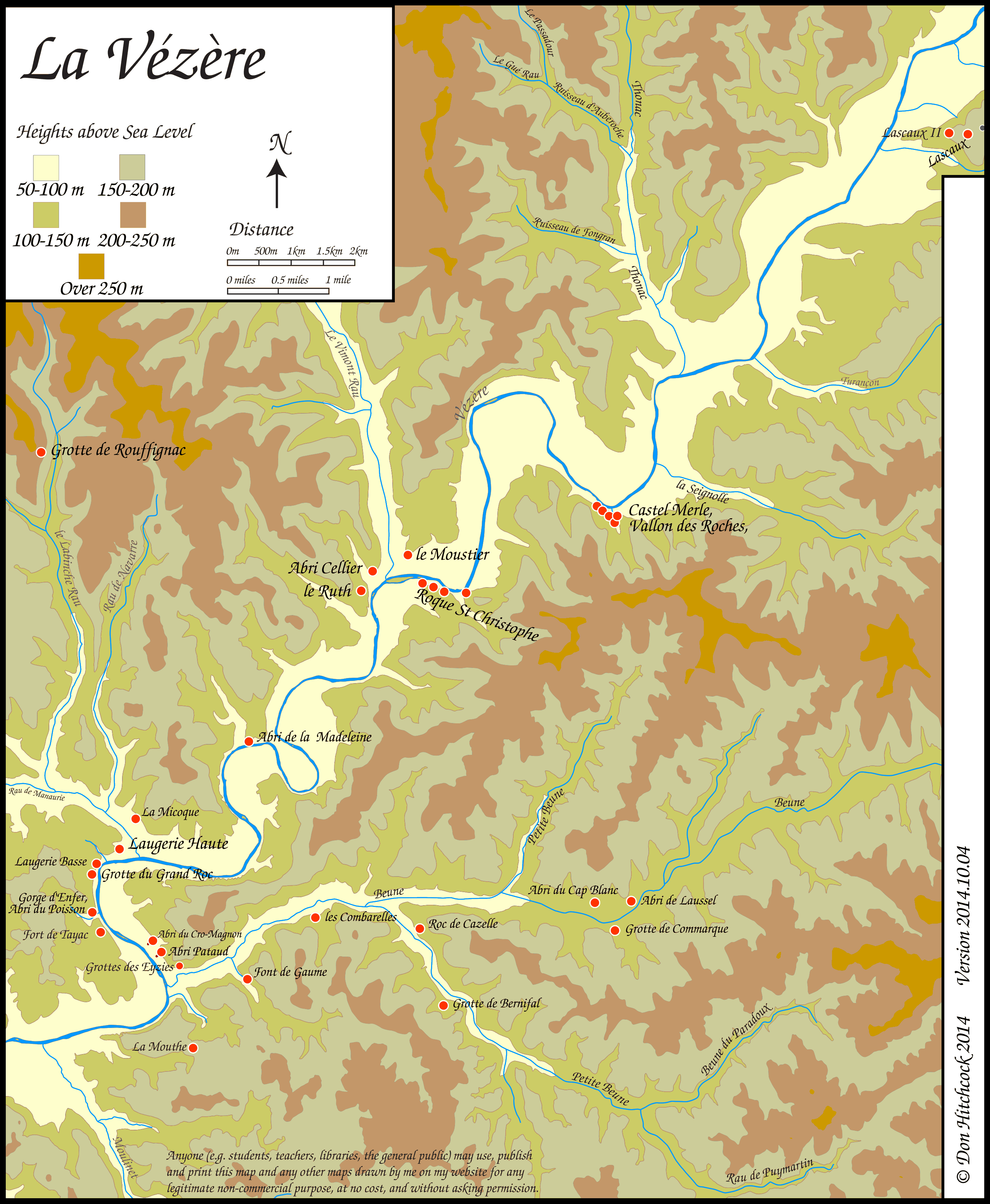
Map of sites in the Vézère Valley of France, including l'abri du Cro-Magnon.
If you click on the map you will see a larger map with the ability to click on the marked sites and get further information.
Photo: Don Hitchcock


The original Cro-Magnon skull.
(note that these photos have been altered from the original superb works of art by Claire Artemyz.
Here is the original on the left,
and here is the original on the right - Don )
Photo: © Claire Artemyz, http://www.bradshawfoundation.com/memoires/index.php
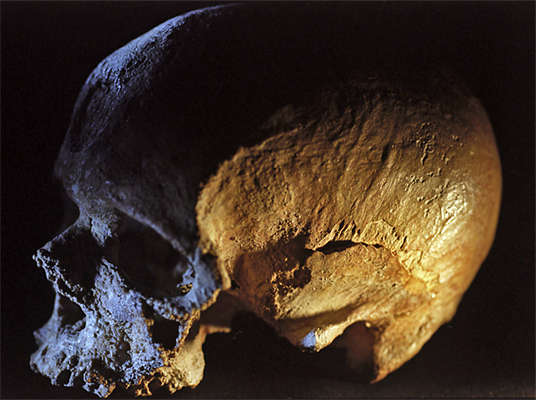
The original Cro-Magnon skull.
(note that this photo has been altered from the original superb work of art by Claire Artemyz.
Here is the original - Don )
Photo: © Claire Artemyz, http://www.bradshawfoundation.com/memoires/index.php
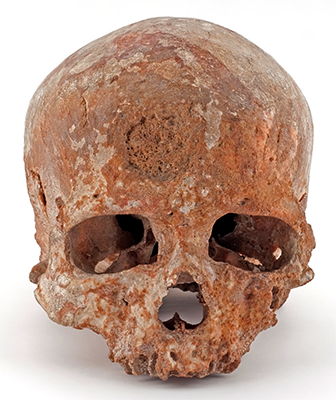
The skull of the man from the Cro-Magnon shelter.
Photo: © Jc Domenech
Source: https://storify.com/public/templates/slideshow/index.html?src=//storify.com/franceinter/visite-virtuelle-du-musee-de-l-homme#39
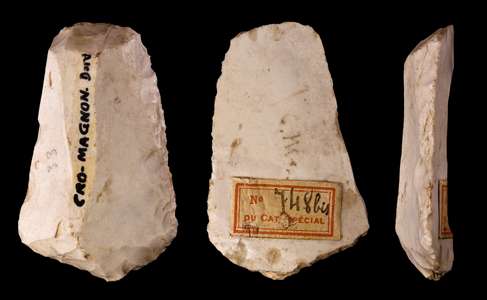
Double edged scraper on a blade from the Cro-Magnon Shelter.
Date: Aurignacian, ca. 45 000 - 35 000 BP
Medium: flint
Dimensions: 47 × 30 × 12 mm (1.9 × 1.2 × 0.5 in) Weight: 15.9 g (0.56 oz)
Current location: Muséum de Toulouse, Accession number MHNT PRE.2010.0.95.3
Findspot: Cro-Magnon, Les Eyzies-de-Tayac-Sireuil, France, collection of Louis Lartet
Photo: Didier Descouens, 2011-03-30
Permission: This file is licensed under the Creative Commons Attribution-Share Alike 3.0 Unported license.

Engraving of a man on the rib of a reindeer.
Label:
Côte gravée
Abri de Cro-Magnon, les Eyzies (Dordogne)
Côte de renne
Photo: Don Hitchcock 2014
Source: Original, Musée d’art et d’archéologie du Périgord, Périgueux
Text below adapted and translated from: Henry-Gambier (2002)
The deposit of Cro-Magnon is located in the town of Les Eyzies-de-Tayac in the north-west of the village, about 150m from the railway station and 600m from the current centre. It consists of a shelter in Cretaceous limestone cliffs overlooking the village on the left bank of Vézère.
Since the excavations of 1868, the appearance of the site has been changed by the collapse of part of the shelter. New buildings were located nearby. Currently, the north-west shelter, a historical monument since 1957, is 3 m deep with a maximum length of approximately 10 m. The south-east extension of the shelter is obscured by the buildings of the Hotel Cro-Magnon.
Discovery and excavation
In 1868, the north-west shelter, 17 m wide and 6 or 7 m deep, was completely filled. An initial disbursement of scree slopes and the removal of a large block of limestone and an overhang occurred during the construction of the Agen-Périgueux railway line opened in 1863.
The uncovering of human remains occurred at the end of March, by workers of the firm of Berthoumeyrou and L. Delmares in charge of the earth works in the embankment for the implementation of the road linking the village to the town of Les Eyzies de Tayac.
An AMS 14C date (27 680 ± 270 BP) of a Littorina shell associated with these human remains demonstrates that they postdate 28 000 BP, indicating that the Cro-Magnon burials should not be interpreted as early Aurignacian. Cultural indications and the AMS date of the shell favour an attribution to the early Gravettian period.
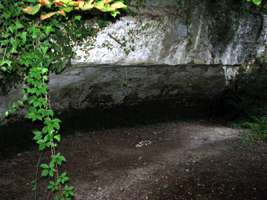
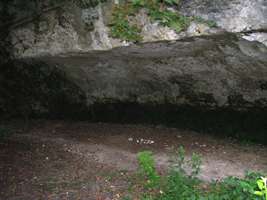
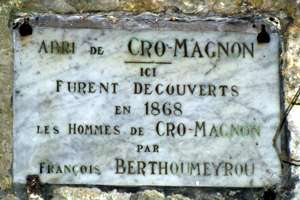
The site has been completely excavated.
Photo: Don Hitchcock 2008
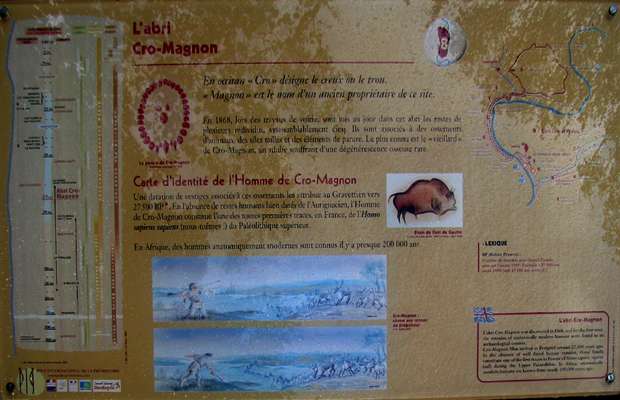
L'abri Cro-Magnon
En occitan << Cro >> désigne le creux ou le trou, << Magnon >> est le nom d'un ancien proriétaire de ce site.
En 1868, lors des travaux de voirie, sont mis au jour dans cet abri lest restes de plusieurs individus, vraisemblablement cinq. Ils sont associés à des ossements d'animaux, des silex taillés et des éléments de parure. Le plus connu est le << viellard >> de Cro-Magnon, un adulte souffrant d'une dégénérescence osseuse rare.
Carte d'identité de l'Homme de Cro-Magnon
Une datation de vestiges associés à ces ossements les attribue au Gravettien vers 27 500 BP. En l'absence de restes humains bien daté de l'Aurignacien, l'Homme de Cro-Magnon constitue l'une des toutes premières traces, en France, de l'Homo sapiens sapiens (nous-même!) du Paléolithique supérieur.
En Afrique, des hommes anatomiquement modernes sont connus il y a presque 200 000 ans.
BP (Before Present): Système de datation pour lequel l'année zéro est l'année 1950.
Photo: Don Hitchcock 2008
Source: display at l'Abri Cro Magnon.
The Cro-Magnon shelter
In occitan "Cro" refers to a hollow or hole,"Magnon"is the name of a former owner of the site.
In 1868, during road works, the remains of several individuals, probably five, were identified in this shelter. They are associated with the bones of animals, knapped flint and jewellery. The best known is "The Old Man of Cro-Magnon", an adult suffering from a rare bone degeneration.
Identity Card of the Man of Cro-Magnon
A dating of remains associated with this site attributes to the bones a Gravettian age of 27 500 BP. In the absence of well-dated human remains from the Aurignacian, l'Homme Cro-Magnon is one of the earliest evidence in France of Homo sapiens sapiens (ourselves!) of the Upper Paleolithic.
In Africa, anatomically modern humans are known from 200 000 years BP.
BP (Before Present): Dating system where year zero is the year 1950.
Text: Translated and adapted from the display at l'Abri Cro Magnon.
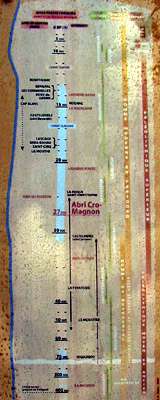
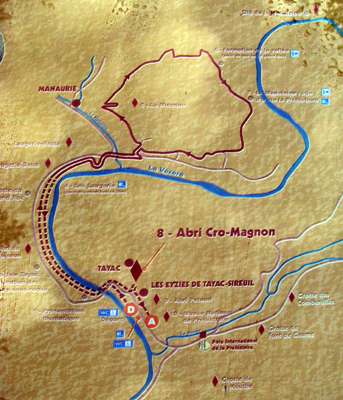
Left: Timeline for sites in the area.
Right: Map of sites in the area.
Photo: Don Hitchcock 2008
Source: display at l'Abri Cro Magnon.
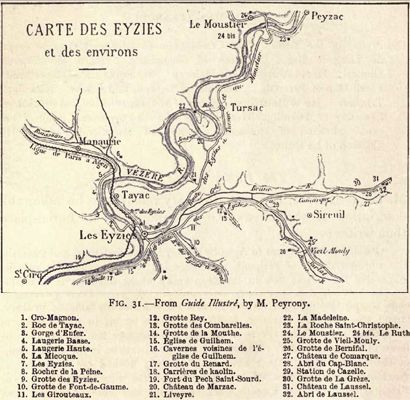
Map of the Les Eyzies area
Photo: Guide Illustré, by M. Peyrony published in Munro (1912)
Littorina littorea used for AMS 14C dating (CM 8682, 1868, collection Lartet, MAN).
Photo D. Gambier.
Photo: Henry-Gambier (2002)
Examination of the series (N = 29) of the shells at the musée des Antiquités demonstrates that there are no fossil shells. The tests appear at first glance to be very well preserved, with preservation of some of the colors. They have scars (breakage and / or polishing of the apex of labrum, wear on the outer surface showing growth striations) indicating that the animals died when the shells were cast up by the surf on a beach. There are many other examples of these changes typical of shells rolled by the sea.
Littorina littorea (CM 8682, 1868, collection Lartet, MAN). Photo M. Vanharen.
(Note also that all of the shells pictured have been pierced to allow threading on a cord as personal decoration - Don)
Photo, and text adapted and translated from: Henry-Gambier (2002)
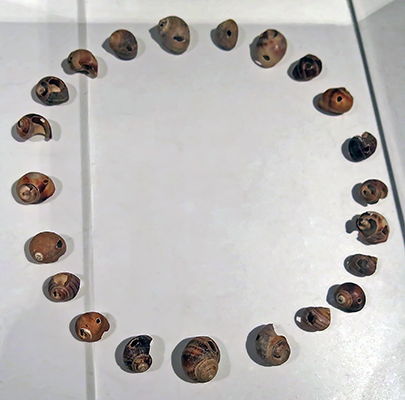
Shells discovered on the skeleton of the man from the Cro-Magnon shelter.
Material: Littorina littorea and Purpura lapillus
Age: Magdalenian
Photo: Don Hitchcock 2015
Source and text: Originals, Musée d'Aquitaine à Bordeaux

Shells discovered on the skeleton of the man from the Cro-Magnon shelter.
Photo: © Jc Domenech
Source: https://storify.com/public/templates/slideshow/index.html?src=//storify.com/franceinter/visite-virtuelle-du-musee-de-l-homme#23
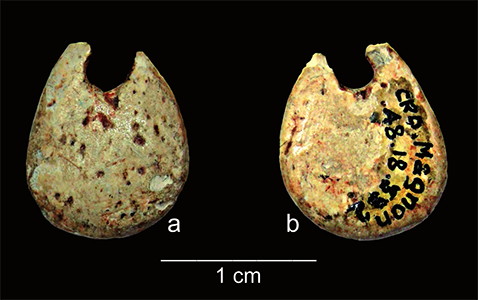
This image shows the two faces of a 'pumpkin seed' pendant found at l'abri Cro-Magnon.
Abri Cro-Magnon: pendeloque n° 48-18-582, faces 1 (a) and 2 (b).
Photo: D. Henry-Gambier, collection MNHN, Muséum National d’Histoire Naturelle
Source and text: Henry-Gambier et al. (2013)
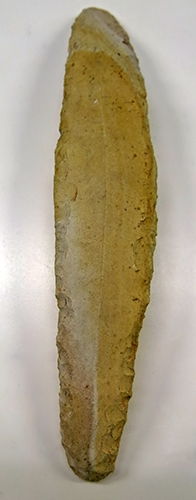
Aurignacian grattoir double, double ended scraper, from l'abri de Cro Magnon, Les Eyzies de Tayac
Photo: Don Hitchcock 2015
Catalog: 60.419.1
Source: Original, Musée d'Aquitaine à Bordeaux
Cro-Magnon 1 Skull.
Photo: Daniel Ponsard / Musée de l'Homme
Source: http://www.savoirs.essonne.fr/
Discovery of the site
Lartet (1868, p. 341-342) describes it thus: "After removing the 4 m of rubbish covering the shelter, workers entering under the rock bench that they had reached, soon removed broken bones, cut flints, and human skulls which were recognised as important and of scientific interest. They immediately stopped their work and hastened to prevent any further damage. The exhumation occurred after a few days in the presence of MM Galy and Simon de Périgueux, two skulls and some other fragments of the human skeleton and bones of reindeer and many worked flints. It was at that moment that I arrived at Les Eyzies where it was soon possible to conduct regular and systematic excavation of the tomb and its surroundings. "
Traces of tools on several recent observations of the bones clearly indicate that the interruption of the work was not immediate. The discovery was undoubtedly very "traumatic" for the remains and the upper part of the filling.
The skeletons were sent to the Muséum National d'Histoire Naturelle in Paris to study. A pillar supporting the roof was built and L. Lartet conducted a search of the deposits underlying the burial and the surroundings of the site.
The exhumation of the skeletons was held at the end of March 1868 and the communication of L. Lartet to the Sorbonne, a few days after April 16.
In less than fifty years, the deposit was completely excavated.
No plan and no cut stratigraphic exploitable have been published, the most complete information comes from the writings of L. Lartet.
Notes on the stratigraphy of the site and the stratigraphic position of the burial
Lartet identifies 11 levels (A to K), their description leads to two sets:
A lower (A to H) rich in human remains. 3 m thick, it consists of alternating levels of sterile detritus (A, C, E) and anthropogenic levels fairly well individualized (B, D, F, G, H) show phases of human settlement and phases of abandonment.
A higher ensemble of deposits (I, J, K) which - except for burial - is poorer in human remains. Thicker than 1 m to 1.50 m, this whole "seems to have been separated from all lower by a series of slabs of limestone from at least one episode of collapse of the roof of the shelter"
All records indicate that the burial was at the bottom of the shelter. However, its precise relationship with the episodes of dismantling the vault and the level J, very thin, are difficult to establish since they have not been observed by L. Lartet.
The burial is not, according to L. Lartet, contemporary with the earliest levels. It is after the introduction of the H level and earlier than the level K, the last episode of non-occupation.
There is evidence in the materials of excavations of the shelter of Aurignacian blades, scrapers on blades, smoothers decorated or not, split based spears and burins.
Tools such as chisels and scrapers were identified in the Bourlon collection (Institute of Human Paleontology, Paris). At least part of the "harvest" of the family Berthoumeyrou which constitute the bulk of the Bourlon collection were made in level H.
This brief review of information on the archaeological material shows that Cro-Magnon was a much more extensive and complex source than suggested by the first excavations.
The shell used for dating was fairly well preserved, was devoid of traces of consolidating or varnish which may give younger dates. Secondary carbonates were removed by acid treatment.
Dating carried out on one of the littorina shells gave an age of 27 680 BP ± 270 (Beta -157439).
Comparison of the stratigraphic and archaeological data from the Cro-Magnon site with the results of a carbon-14 dating in SMA carried out on a shell composing the adornment that accompanied the deceased, indicates that the multiple Cro-Magnon burial would be dated to at most 28 000 BP. This result excludes the remains belonging to the early Aurignacian and various clues argue in favour of an attribution to the early or middle Gravettian.
Text above adapted and translated from: Henry-Gambier (2002)
Male Cro-Magnon Skull from Natjaillac (1884)
Cro-Magnon 1 preserved the skeleton of an adult male. The individual was probably middle-aged (less than 50 years old) at his death on the basis of the pattern of closure of cranial sutures. The bones in his face are noticeably pitted.
The skull was complete except for the teeth.
While the Cro-Magnon remains are representative of the earliest anatomically modern human beings to appear in western Europe, this population was not the earliest anatomically modern humans to evolve. The skull of Cro-Magnon 1 does, however, show the traits that are unique to modern humans, including the high rounded cranial vault with a near vertical forehead. The orbits are no longer topped by a large browridge. There is no prominent prognathism of the face. indicative of community support of individuals, which allowed them to convalesce.
Analysis of the pathology of the skeletons found at the Les Eyzies rock shelter indicates that the humans of this time period led a physically tough life. In addition to the infection noted above, several of the individuals found at the shelter had fused vertebrae in their necks indicating traumatic injury, and the adult female found at the shelter had survived for some time with a skull fracture. The survival of the individuals with such ailments is indicative of community support of individuals, which allowed them to convalesce.
Text: adapted from http://anthropology.si.edu/HumanOrigins/ha/cromagnon.html
Photo: Wikipedia
Note that this pitting could be "lumpy jaw" caused by Actinomycosis, which is a chronic infection caused by various bacteria called actinomycetes. These bacteria are commonly found in the mouth and cheeks of humans and some other mammals. They do not cause an infection unless the bacteria enter the body through a break in the skin or the mucus tissues (such as the membranes in the mouth). Actinomycosis most often occurs in the head and neck region. Poor dental hygiene is one possible cause. It usually causes little pain.
Text above adapted from: http://health-search.closerlooksearch.com/health-topics/L/Lumpy-jaw.html
Female Cro-Magnon Skull from Natjaillac (1884)
This adult female found at the shelter had survived for some time with a skull fracture.
Photo: Wikipedia
Female Cro-Magnon Skull.
A woman, probably aged between 35 and 40 years. The sutures of the skull were more closed than would be usual in anatomically modern humans, and the teeth which remained (two molars) were less worn than they would have been had the subject lived to fifty. The subject must in any case have been within the age-limit of child-bearing, whatever this may have been in the race to which she belonged. The dolichocephaly (the head is longer than would be expected, relative to the width of the head) of this woman was even more marked than that of her aged kinsman. Her facial structure displayed similar characters to his, though in a less marked degree, probably owing to the difference of sex.
The back of the skull was damaged, and the cubic capacity could be only approximately estimated; the figure arrived at is 1550 cubic centimetres, which would give this woman a higher cranial capacity than the average modern male of Europe. The skull displays the mark of an intentional act of violence. On the left side of the forehead there is an opening in the bone, about 4 cm in length and 2 cm in breadth, tapering to a point at each end; just such a cut as would have been made by a violent blow from a small stone axe, or more probably a lance-head. The wound was certainly inflicted during life, and probably was the cause of death, which did not, however, take place immediately; there are marks of the natural process of bone-repair, which must have been able to act for some 15 to 20 days after the injury was received to advance as far as it has done. The blow must have been given with great force, as the cut is clean and the bone is not splintered.
Photo and text: Macalister (1921) (Public Domain)
Text below from: Munro (1912)
The Cro-Magnon Skeletons.
The cave, formed by a ledge projecting from a great rock, occupied a space of some 17 metres in length by 8 metres in depth, at a distance of about 130 metres from the railway station of Les Eyzies. At the base of the rock there is a talus, of which a portion was removed in 1868 for the construction of the railway embankment.
During these operations kitchen debris of the reindeer-hunters was exposed, and at once notice of the discovery was given to the authorities. Investigations followed, by order of the Minister of Public Instruction, under the superintendence of M. Louis Lartet. First of all it was necessary to support the vault of the shelter by a pillar, because of a deep crack which threatened its fall.
Section through the Rock-shelter of Cro-Magnon. (After L. Lartet.)
A Debris of the soft limestone.
B First layer of ashes, etc.
C Calcareous debris.
D Second layer of ashes, etc.
E Calcareous debris reddened by fire.
F Third layer of ashes, etc.
G Bed earth, with bones, etc.
H Thickest layer of ashes, bones, etc.
I Yellowish earth, with bones, flints, etc.
J Thin bed of earth-stuff.
K Calcareous debris.
L Rubbish of the talus.
N Crack in the projecting ledge of rock.
P Projecting shelf of hard lime-stone.
Y Place of the pillar made to support the roof.
a Tusk of an elephant.
b Bones of an old man.
c Block of gneiss.
d Human bones.
e Slabs of stone fallen from the roof at different times.
Photo and text: Munro (1912)
Position of human remains in the shelter Cro-Magnon, according to L. Lartet.
P. Cretaceous limestone.
X. Central portion of layer H where it was thickest.
Y. Base of the pillar built to support the roof.
a. Elephant ( mammoth - Don ) tusk.
b. Skull of an old man.
d. Human bones.
e. Slabs of stone fallen from the roof at different times.
m. Skeleton of woman.
n. Bones of children.
Source and text: Lartet and Christy (1875)
Proximal source: archive.org
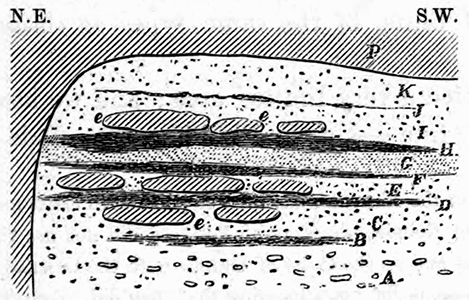
Section of a lateral portion of the Cave along the line γ-δ of the plan above.
A Debris of the soft limestone.
B First layer of ashes, etc.
C Calcareous debris.
D Second layer of ashes, etc.
E Calcareous debris reddened by fire.
F Third layer of ashes, etc.
G Bed earth, with bones, etc.
H Thickest layer of ashes, bones, etc.
I Yellowish earth, with bones, flints, etc.
J Thin bed of earth-stuff.
K Calcareous debris.
Source and text: Lartet and Christy (1875)
Proximal source: archive.org
The culture debris and its various contents are sufficiently indicated by the descriptive details of the figure. It was on the surface of the debris at the back part of the cave that the human skeletons were found. Above the projecting rock and all over the shelter lay a subsequent talus, 4 to 6 metres thick, which had accumulated since the skeletons had been deposited. M. Lartet's description of their position in the cave is as follows :
" As for the human remains and the position they occupied in bed i, the following are the results of my careful enquiries in the matter. At the back of the cave was found an old man's skull, which alone was on a level with the surface, in the cavity not filled up in the back of the cave, and was therefore exposed to the calcareous drip from the roof, as is shown by its having a stalagmitic coating on some parts. The other human bones, referable to four other skeletons, were found around the first, within a radius of about 1.50 metres. Among these bones were found, on the left of the old man, the skeleton of a woman, whose skull presents in front a deep wound made by a cutting instrument, but which did not kill her at once, as the bone has been partly repaired within ; indeed our physicians think that she survived several weeks. By the side of the woman's skeleton was that of an infant which had not arrived at its full time of foetal development. The other skeletons seem to have been those of men.The skull of the "old man" (cephalic index 73.6 and capacity 1590 cubic centimetres) presents osteological characters closely approximating to those of the normal type of modern Europeans (Figs. 33 and 34). From actual measurements the height of this man was calculated to be 1.82 metres. The lower jaw has large ascending rami, behind which the third molars are partly hidden. Moreover, these two teeth, instead of being the same size as the other molars, are smaller a peculiarity of dentition which is of common occurrence among men of Neolithic times, and normal among modern civilised races. M. Lartet believed that these skeletons belonged to the later Palaeolithic people of the locality ; but in the opinion of some anthropologists this inference is not justified from the facts. The bodies lay on the surface of the culture strata in a small open space between it and the roof, the opening to which had been closed by heaping up the Palaeolithic debris ; so that the interment could have taken place long after the shelter had ceased to be inhabited.
"Amidst the human remains lay a multitude of marine shells (about 300) each pierced with a hole, and nearly all belonging to the species Littorina littorea, so common on our Atlantic coasts. Some other species, such as Purpura lapillus Turritella communis, etc., occur, but in small numbers. These also are perforated, and, like the others, have been used for necklaces, bracelets, or other ornamental attire. Not far from the skeletons, I found a pendant or amulet of ivory, oval, flat, and pierced with two holes. M. Laganne had already discovered a smaller specimen ; and M. Ch. Grenier, schoolmaster at Les Eyzies, has kindly given me another quite similar, which he had received from one of his pupils. There were also found near the skeletons several perforated teeth, a large block of gneiss, split and presenting a large smoothed surface; also worked antlers of reindeer, and chipped flints of the same types as those found in the hearth-layers underneath." (Ibid. p. 70.)
Side and front views of the Skull of the " old man of Cro-Magnon." (Reliquiae Aquitanicae)
Munro (1912)
At the time the grave-goods were also supposed to be in keeping with burials of the early Neolithic period ; but this objection is no longer tenable since the discovery of Palaeolithic burials in the Grimaldi caves and elsewhere containing grave-goods precisely similar to those of the Cro-Magnon interment.
Skulls and Bones
C. PLATE IX & X.
(Double.)
[All the figures, drawn on the stone from the originals, are reversed in the plate. They were sketched in geometric projection by aid of Gavard's diagraph, and reduced to half-size by Sauvage's pantograph.]
_________
Fig. 1a. La Madelaine.
Frontal, front view.
1 b. Internal cast of the same.
_________
Fig. 2. Cro Magnon.
Half of the Upper Jaw of "No. 4" from Cro-Magnon, with the second premolar and the first two molars still in place and much worn.
_________
Fig. 3. La Madelaine.
Portion of the lower jaw of the Man of La Madelaine.
_________
Fig. 4. Cro Magnon.
Fragment of the Lower Jaw of "No. 4" from Cro-Magnon, bearing two molars much worn.
_________
Fig. 5. Cro Magnon.
First lumbar Vertebra of the "Old Man" of Cro Magnon, showing the separation of the diapophysis into a metapophysis and parapophysis.
_________
Fig. 6a. Cro Magnon.
The Pelvis of "No. 1" from Cro Magnon, reconstructed by M. Hamy : represented as seen from above, and so that the plane of the upper narrowing is horizontal.
6b. The same, seen from behind, for the particular study of the sacrum.
_________
Fig. 7. Cro Magnon.
Shaft and upper extremity of a left radius from Cro Magnon, view of the anterior surface.
_________
Fig. 8. Cro Magnon.
Shaft and lower extremity of another radius from the same place, view of the posterior surface, to show the depth of the grooves.
_________
Fig. 9. Cro Magnon.
Left ulna of one of the subjects from Cro Magnon, profile, to exhibit the incurvation of the upper extremity.
_________
Fig. 10a. La Madelaine.
Right Femur of the Man of La Madelaine, anterior surface.
10b. Profile of the same, to show its antero-posterior curve and the flattening of the upper fourth of its outer edge.
10c. Section of this Femur at its narrowest point, showing the projection of the linea aspera in the form of a small column.
_________
Fig. 11 a. La Madelaine.
Right tibia of the same subject, represented in profile, to give an idea of the amount of its transverse flattening.
11 b. Section of the same bone at the level of the foramen nutritium, showing the lozenge-shape resulting from platycnemism.
_________
Fig. 12. Laugerie Basse
Right fibula of the Man of Laugerie Basse "No. 4" with the deep groove in its outer surface.
_________
Fig. 13a, 13b, 13c. Laugerie Basse
The left first Metatarsal of the same, views of the dorsal and plantar surfaces and profile, to show the extent of its metatarso-phalangial surface of articulation.
_________
Fig. 14. Cro Magnon
Astragalus of the "Old Man" of Cro-Magnon, seen from above.
_________
Fig. 15. Cro Magnon
Cuboid from the same subject, in the same position.
Source and text: Lartet and Christy (1875)
Proximal source: archive.org
References
- Delluc G., 2010: Histoires d'Os au Paléolithique, Adamap XIIIe Conférence, Paleos', 2010
- Groenen M., 1994: Pour une histoire de la préhistoire, Éditions Jérôme Millon 1994
- Henry-Gambier, D., 2002: D. Henry-Gambier, «Les fossiles de Cro-Magnon (Les Eyzies-de-Tayac, Dordogne) : Nouvelles données sur leur position chronologique et leur attribution culturelle», Bulletins et Mémoires de la Société d'Anthropologie de Paris [En ligne], Tome 14, Fascicule 1-2 (2002), Mis en ligne le : 15 août 2005 Disponible sur : bmsap.revues.org/document459.html.
- Lartet, L.., 1868 Mémoire sur une sépulture des anciens troglodytes de Périgord, Annales des sciences naturelles II Zoologie, 5ème Série, X, 1868,p. 141, fig. 6
- Macalister, R., 1921: A text-book of European archaeology Cambridge, Univ. Press
- Munro, 1912: Paleolithic Man and Terramara Settlements in Europe, Edinburgh: Oliver & Boyd. 1912 (out of copyright)
- Natjaillac, Marquis de., 1884 Die ersten Menschen und die prähistorischen Zeiten mit besonderer Berück- sichtigung der Urbewohner Amerikas, herausgegeben von W. ScHLössEK und Ed. Seler. Stuttgart. Verlag von F. Enke, 1884.
Back to Don's Maps
Back to Archaeological Sites
 Back to the review of hominins
Back to the review of hominins
